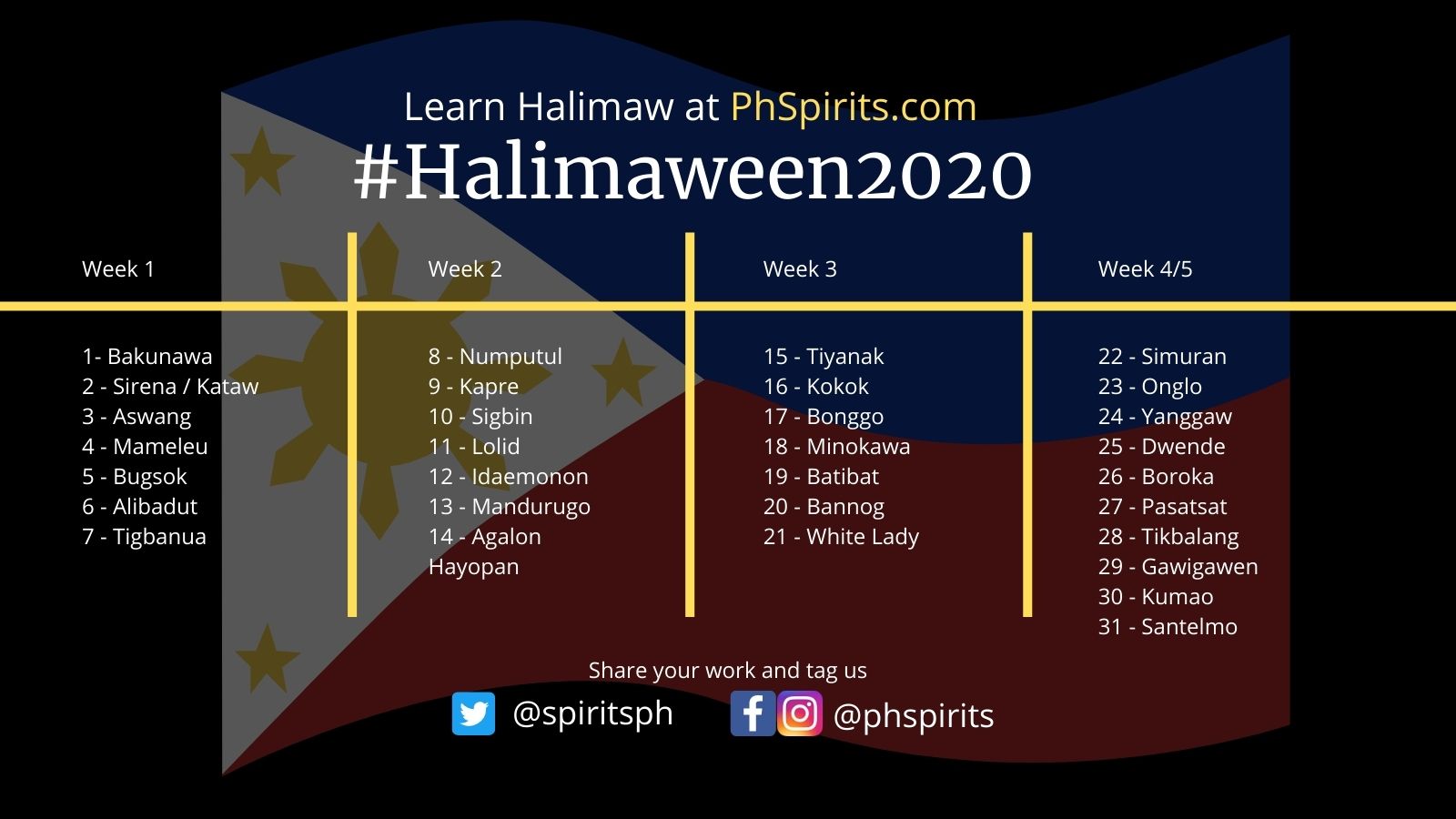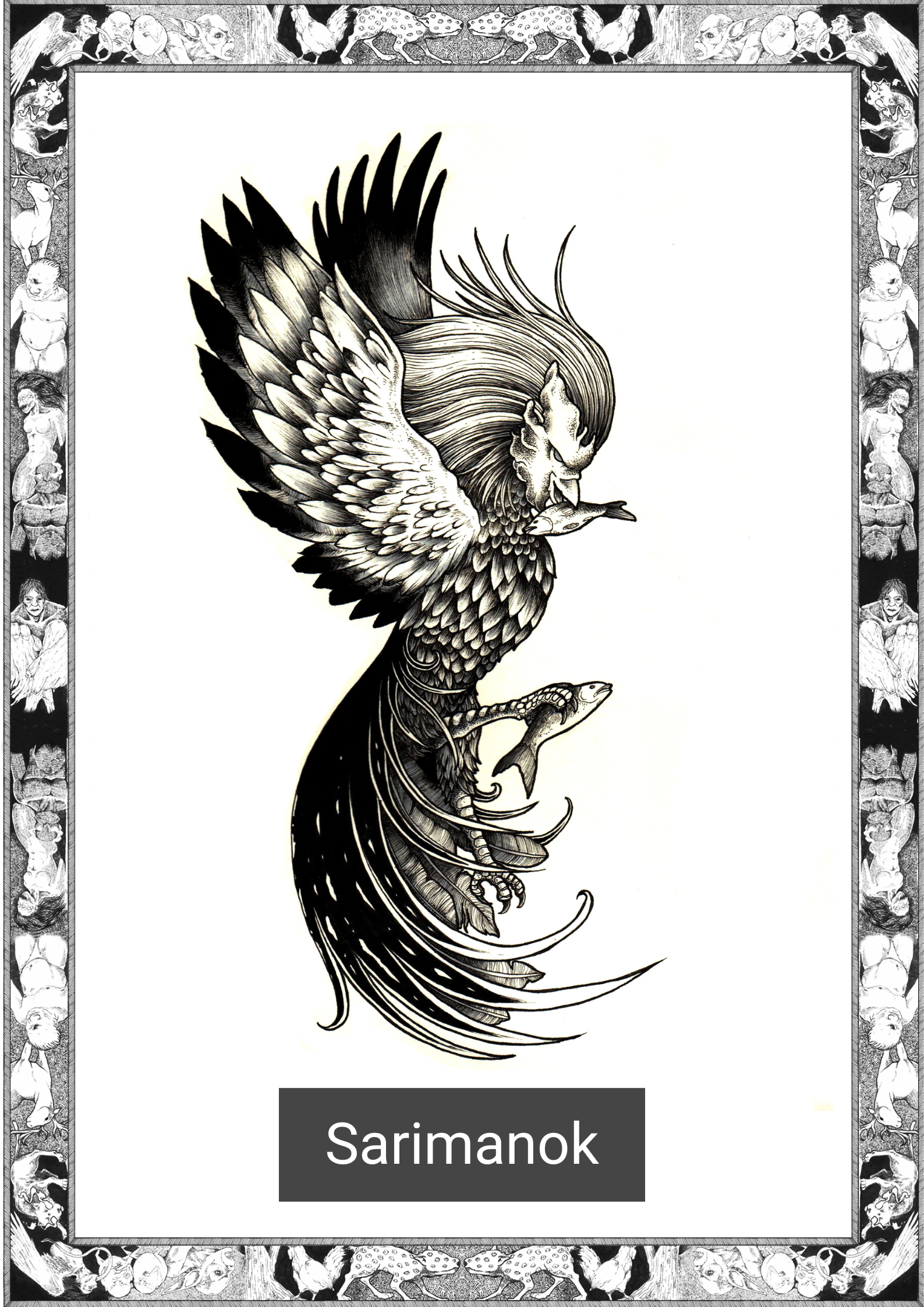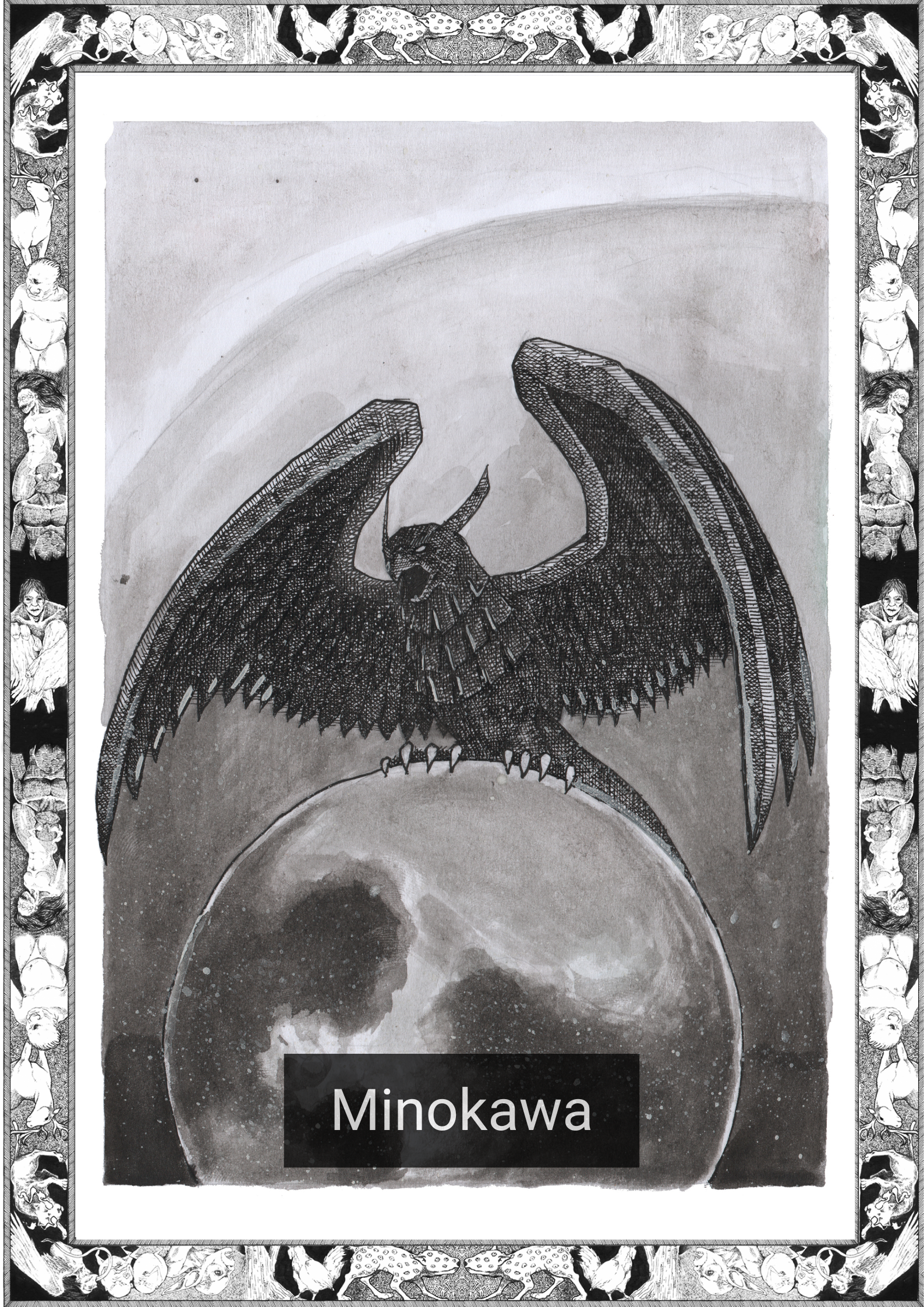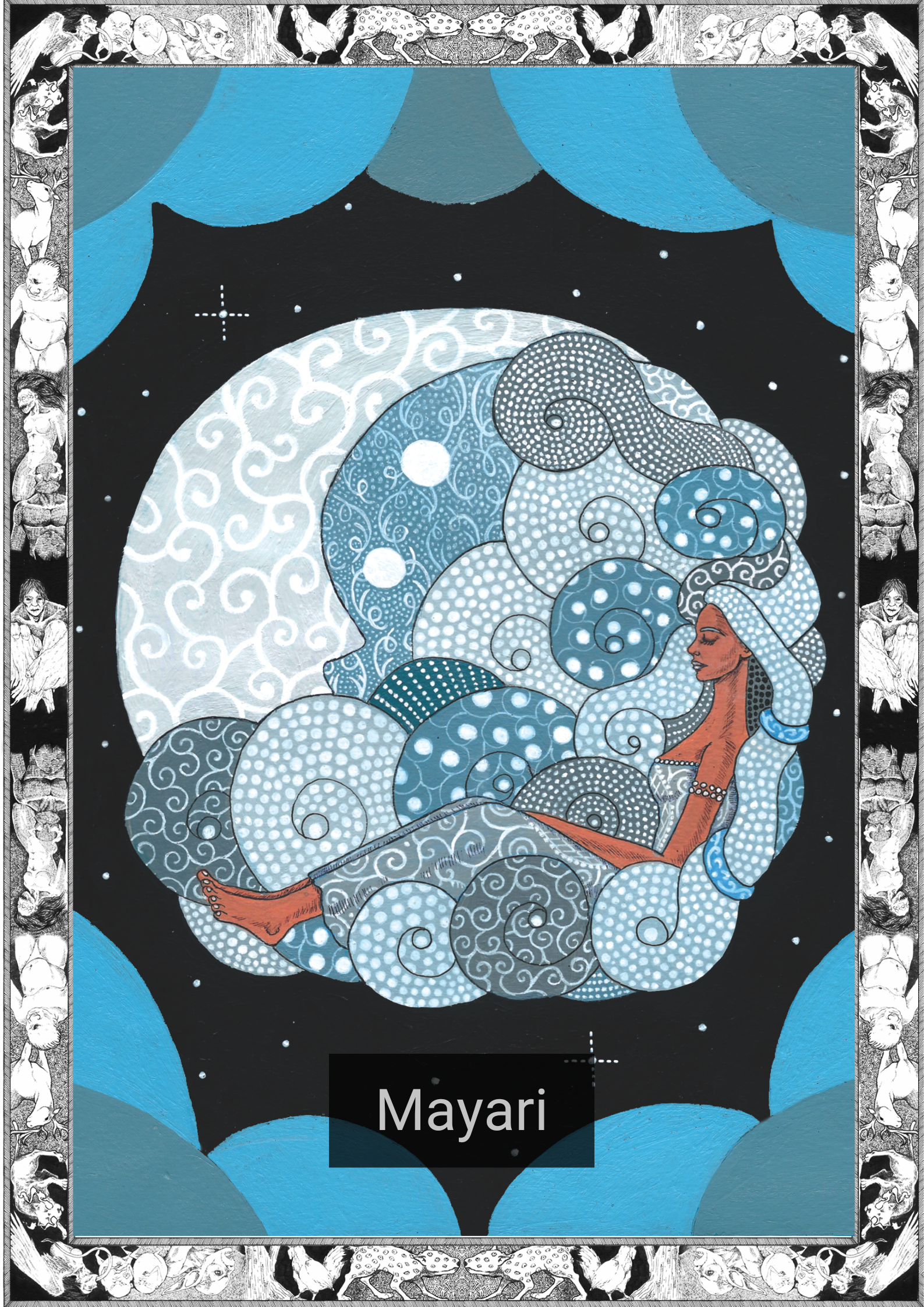“Halimaw” is a word that means “monster” or “beast” in Tagalog.
Challenge yourself by creating work in any medium inspired by these Halimaw we have researched from Philippine culture.
Use #Halimaween2020 and tag us to share and discover other work!

Week 1
1 – Bakunawa – A serpent or dragon that is believed to eat the sun or moon during an eclipse. Is kept at bay by loud noise and music. It seeks to possess all 7 moons by swallowing them. The Bakunawa already swallowed 6 moons, but was stopped by the god Bathala from eating the last one.
2 – Sirena / Kataw – A fish that has features of a woman on half of its body or ‘a likeness of a person’ that has a fish tail.’ In stories it always possesses great treasures, usually gold. Has an affinity with fish and magical control of water. It can be stopped by stabbing the water with a steel instrument. When she wants to, its tail becomes legs and is able to walk on land. It has a sweet voice and is a good singer. It may seek tribute (usually the sacrifice of a small child). Prefers ambush tactics when capturing their prey.
3 – Aswang – The term ‘Aswang’ is applied to creatures with varying descriptions. And depending where in the Philippines you are, ‘Aswang’ can mean many different things. They can be:
Bloodsucking vampires or cannibals – In some beliefs, ‘Aswang’ are warriors who have eaten human flesh.
Self-segmenters – In some parts of Eastern Visayas, Quezon Province and other areas ‘Mananaggal’ and ‘Aswang’ are synonymous. ‘Mananaggal’ refer to creatures that can split in half and fly, usually eating the innards of their victims.
Shapeshifters – Some ‘Aswang’ can turn into dogs, cats, black pigs, birds.
Witches – They can cause illness to people from afar as well as other magic like turning corpses into other objects. Some Spanish sources claim they have made a pact with the devil.
Corpse Eaters – Some descriptions have ‘Aswang’ as exclusively eaters of dead bodies.
They can also be any combination of the descriptions above.
4 – Mameleu – A sea serpent, its body as large as a carabao and thirty fathoms long. It has two torch like eyes that gleam like fire. Its head as large as a carabao’s with two white horns and long tusks and teeth. It has plate sized scales that are hard and resistant. It lives in the depths of the ocean in secluded places where boats had sunk in the water. It ejects green spittle when hungry .
5 – Bugsok – A black being that walks on its hands, upside down. If it is harmed by playing children it causes their legs to swell, from the knee down. This pain causes the children to raise their legs and use their hands to walk, eventually making more bugsok.
6 – Alibadut – A head facing backwards trailed by internal organs. With its face facing backwards, it flies at night only with its innards. It leaves its body behind in the bushes to look for pregnant women … . When it finds one it sticks its “magical” tongue out from the crevices of the rooftop to suck the woman’s viscera, the placental fluid, and the fetus.
7 – Tigbanua – It has one eye in the middle of the forehead, a hooked chin that spans long upturns to catch the drops of blood that drip from the mouth and has coarse black hair bristles on the body. It is said to be the most malignant of the busaw.
Week 2
8 – Numputul – A jolly creature with a decapitated neck. It walks around the woods or fields with a severed head. Their neck stump bubbles and froths.
9 – Kapre – It takes the form of a bearded man of enormous size with a complexion as black as coal. It Smokes a roll of tobacco as big as a banana trunk. It lives in Balete trees or other large trees. It can change size from a small mannequin to as large as a church tower.
10 – Sigbin – Except for their large round ears, it has an ambiguous appearance. People have problems identifying which end is the head and which one is the tail as they can run fast either forward or backwards. Looks like a locust or a frog or looks like a goat without horns, long hind legs like a kangaroo and large ears that it can flap. It has a long tail that it uses to whip victims. It is surrounded by an unpleasant smell and hastens the death of sick people. A person is said to die if the sigbin bites them/their shadow.
11 – Lolid – They look like new born puppies or piglets, but in other sources they are described as wrinkly-skinned infants without limbs and have a big heads. If you accidentally step on a lolid, sickness will follow and nothing can cure it except for a ritual performed by a babaylan.
12 – Idaemonon – They appear as fingers poking out of the ground. If you step on its finger, you get sick. It pokes its fingers through the ground every 6am and 6pm. When it decides to come out of the ground, it tends to hide some of your things.
13 – Mandurugo – Would pose as a beautiful woman and marry its victim. Every night it slowly drinks the blood of its victim until he weakens and dies, after which it searches for its next victim. In other stories it kidnaps children and uses their blood to fortify the bridges or buildings it creates. It also puts blood on jewelry it later buries. It can be killed with a bamboo stake.
14 – Agalon Hayopan – Inactive aswangs, they prefer to live right by the river where crocodiles are plentiful. They desire to eat human flesh and employ crocodiles to kill people and discreetly bring their flesh to them.
Week 3
15 – Tiyanak – It takes the form of a naked, newborn baby. They are said to be the souls of babies that died without being baptized. They want to play with whoever passes by them, their favorite playmates are children with uncommon names. They crow like a bird and they cry to lure childless couples, then they wait until they find an opportunity to kill the couple by sucking their blood.
16 – Kokok – It has a pointed head with pointed eyes and a pointed long nose. It is about the same size as a human. They say that when you are walking in the forest and you feel someone touch you from behind and you see no one it is the kokok playing tricks because of this you do not notice that you are already lost from your fellow company.
17 – Bonggo – Vengeful human-like spirits with fire-spitting eyes. They aid the aswang, acting like black priests. Their eyes make other creatures cower in terror. They are afraid to cross rivers, when they touch water their fire is extinguished. When this happens, they die.
18 – Minokawa – It is Bird-like and as large as the islands of Negros and Bohol. Its beak and talons are steel-like, its eyes are mirrors and its feathers are sharp swords. It lies in wait for the moon and tries to seize her in its mouth when she emerges from one of her holes in the eastern horizon. If the Minokawa swallows both the sun and the moon it is feared that it will descend to earth and devour people as well.
19 – Batibat – It takes the form of a large, obese woman. It resides in trees. In dreams it bars the door that would let its victims leave. It deals ‘bangungot’ or madness upon its victims. To escape the batibat one must bite their thumb or move their toes. If a person saves themselves from a batibat they become ‘naluganan’, gaining the ability to see spirits.
20 – Bannog – Large, bird like creatures. They are strong enough to lift a carabao, but are easily tricked. They have motherly instinct for their young.
21 – White Lady – Female ghosts often seen wearing flowing white robes or gowns. Their long black hair covers their faces. Some may be seen without heads or with rotting flesh. Some say they are spirits of wronged women seeking revenge.
Week 4/5
22 – Simuran – Simuran is one of two kuruntangs (giants) that guard the gates of Kanitu-nituhan (Part of the Bisayan underworld).
Sisiburanen (A god responsible for the souls in kanitu-nituhan) feeds souls to the two giants.
23 – Onglo – A human-like creature with long straight, black hair around its body from head to toe. It has clawed feet, long, sharp fingernails and long, pointy ears. It is surrounded by a fetid smell. It feeds on food left to dry in the sun, like dried fish. Any person that touches the hair of the onglo will itch all over.
24 – Yanggaw – A newly turned aswang. They have an insatiable hunger for blood.
25 – Dwende – Dwende are sometimes classified into black or white. White dwende do not harm humans, they live in ceilings and attics and the house owner hears their laughter sometimes. Black dwende are malevolent and can cause illness or death. If a black dwende inhabits a house its occupants are doomed to find all kinds of ill luck. Otherwise they are described as little men with long beards that can teach people magic. This includes the power to heal the sick and the power to appear in another place.
26 – Boroka – Has wings like a bird and the head of a woman or a beautiful woman that can detach the lower portion of her body. Can transform into a bird. Cannot reattach her body if ashes and a mixture of salt and vinegar is placed on her lower half. Eats the hearts and livers of her victims. Prefers human children, is fond of their livers. May abduct young humans and keep them as housekeepers, feeding them flesh and liver.
27 – Pasatsat – Apparitions that are covered in bamboo mats, they are ghosts of people who died or were killed in the Second World War. During the Japanese occupation in the Philippines, burial in a coffin was uncommon as it was considered too costly by the locals who already suffered financial losses. Instead, the dead were wrapped in sleeping mats and buried away from the communal cemetery to avoid grave-robbing. The Pasatsat usually show up in solitary roads, blocking lone travelers. In order to get rid of the ghost, one must stab it. This would cause the mat to unroll, the corpse it once contained nowhere to be found, and emit a putrid odor of rotting flesh.
28 – Tikbalang – It has the head of a horse, the body of a human and long legs. It has a hairy head and back, long ears and large teeth. Can assume the shape of an old man, a horse or a monster. Brings sickness.
29 – Gawigawen – A man-like giant it has six heads and possesses a spear and headaxe ‘as big as half the sky’
30 – Kumao – Large ‘man’/ ‘ogre’. It takes children and bleeds them to death by pulling out their fingernails.
31 – Santelmo – Multicolored balls of fire, they are formed when sunlight comes into contact with spilled human blood.




